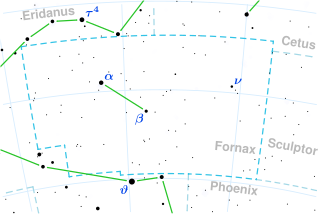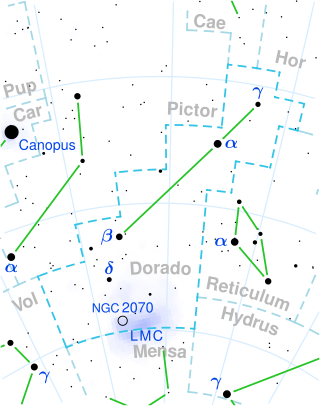
Chi Virginis is a double star in the constellation Virgo. Based upon parallax measurements, it is approximately 315 light-years from Earth. It has an apparent visual magnitude of 4.65, which is bright enough to be seen with the unaided eye under suitable viewing conditions.
HD 38529 is a binary star approximately 138 light-years away in the constellation of Orion.
HD 17092 is a star in the constellation of Perseus. It has an orange hue but is visible only with binoculars or better equipment, having an apparent visual magnitude of 7.73. The distance to this star is approximately 750 light years from the Sun based on parallax, and is drifting further away with a radial velocity of +5.5 km/s.

HD 47536 is a single star in the southern constellation of Canis Major. It has an orange hue and is dimly visible to the naked eye with an apparent visual magnitude of +5.25. The star is located at a distance of approximately 408 light years from the Sun based on parallax. It is drifting further away with a radial velocity of 80 km/s.
HD 59686 is a binary star system in the northern constellation of Gemini. It is visible to the naked eye as a dim point of light with an apparent visual magnitude of +5.45. The distance to this system is approximately 292 light years based on parallax, but it is drifting closer with a radial velocity of −34 km/s.

HD 13189 is a star with an orbiting companion in the northern constellation of Triangulum constellation. With an apparent visual magnitude of +7.57, it is too faint to be visible to the normal human eye. The distance to this system is approximately 1,590 light years based on parallax measurements, and it is drifting further away with a radial velocity of 25.39 km/s. In 2005, a planetary companion or brown dwarf was announced in orbit around this star.
81 Ceti is a star located approximately 331 light years away from the Sun in the equatorial constellation of Cetus. 81 Ceti is the Flamsteed designation for this object. It is visible to the naked eye as a dim, yellow-hued point of light with an apparent visual magnitude of 5.65. The star is drifting further away from the Earth with a heliocentric radial velocity of +9 km/s.
HD 171238 is a star with an orbiting exoplanet in the southern constellation of Sagittarius. It is located at a distance of 145 light years from the Sun based on parallax measurements, and is drifting further away with a radial velocity of 21 km/s. The star has an absolute magnitude of 5.15, but at the distance of this system it is too faint to be viewed with the naked eye, having an apparent visual magnitude of 8.61.
HD 190984, also known as HIP 99496, is a star located in the southern circumpolar constellation Pavo, the peacock. It has an apparent magnitude of 8.76, making it readily visible in small telescopes, but not to the naked eye. Based on parallax measurements from the Gaia spacecraft, the object is estimated to be 486 light years away from the Solar System. It appears to be receding with a heliocentric radial velocity of 20.3 km/s.
HD 103197 is a star with a planetary companion in the southern constellation of Centaurus. It has an apparent visual magnitude of 9.40, which is too faint to be viewed with the naked eye. Based on parallax measurements, HD 103197 is located at a distance of 187 light years from the Sun. It is drifting closer with a radial velocity of −4.6 km/s.
HD 173791 is a solitary yellow hued star located in the southern constellation Telescopium. It has an apparent magnitude of 5.80, allowing it to be viewed with the naked eye under suitable viewing conditions. Parallax measurements place the object at a distance of 364 light years, and it is currently receding from the Solar System with a heliocentric radial velocity of 9.7 km/s.
75 Ceti is a single star in the equatorial constellation of Cetus with at least two planets. It is visible to the naked eye as a dim, orange-hued star with an apparent visual magnitude of +5.36. The star is located 268 light-years distant from the Sun, based on parallax, but is drifting closer with a radial velocity of −6 km/s.
HD 100655 is a star in the zodiac constellation of Leo, located 449 light years away from the Sun. It has an apparent visual magnitude of +6.45, which makes it a challenge to see with the naked eye under ideal viewing conditions. The star is moving closer to the Earth with a heliocentric radial velocity of −5 km/s. It has one confirmed planet.
HD 112410 is a star in the southern constellation of Musca. It has a yellow hue and is too dim to be readily visible to the average sight, having an apparent visual magnitude of 6.86. The distance to this star is 513 light years based on parallax, and it is drifting further away from the Sun with a radial velocity of 73 km/s. It has an absolute magnitude of 1.22.
63 Ceti is a star in the constellation of Cetus, located just over a degree south of the celestial equator. With an apparent magnitude of about 5.9, the star is barely visible to the naked eye as a dim, orange-hued point of light. Parallax estimates put it at a distance of about 390 light years away from the Earth, and it is drifting further away with a radial velocity of 28 km/s.

λ1 Fornacis, Latinized as Lambda1 Fornacis, is a red giant star in the southern constellation of Fornax. It is just visible to the naked eye as a dim, yellow-hued point of light with an apparent visual magnitude of 5.91. The star is located 383 light years from the Sun, based on stellar parallax, and is drifting further away with a radial velocity of +10 km/s.
HD 121056, or HIP 67851, is an aging giant star with a pair of orbiting exoplanets located in the southern constellation of Centaurus. This star is dimly visible to the naked eye with an apparent visual magnitude of 6.17. It is located at a distance of 209 light years from the Sun, based on parallax measurements, and is drifting further away with a radial velocity of 5.6 km/s.

HD 34266, also known as HR 1721 is a solitary, yellow hued star located in the southern constellation Columba, the dove. It has an apparent magnitude of 5.73, making it faintly visible to the naked eye under ideal conditions. Based on Gaia DR3 parallax measurements, the object is located 539 light years away. It appears to be drifting away from the Solar System, having a heliocentric radial velocity of 13.2 km/s.

Lambda Doradus, Latinized from λ Doradus, is a solitary yellow hued star located in the southern constellation Dorado. It has an apparent magnitude of 5.13, making it faintly visible to the naked eye if viewed under ideal conditions. Parallax measurements place the star at a distance of 551 light years, and it is currently receding with a heliocentric radial velocity of 10 km/s.
HD 222060, also known as HR 8957, is a solitary, orange hued star located in the southern circumpolar constellation Octans. It has an apparent magnitude of 5.98, allowing it to be faintly visible to the naked eye. Based on parallax measurements from GAIA, the object is estimated to be 536 light years distant. It appears to be slowly receding from the Solar System, having a heliocentric radial velocity of 2.3 km/s.






